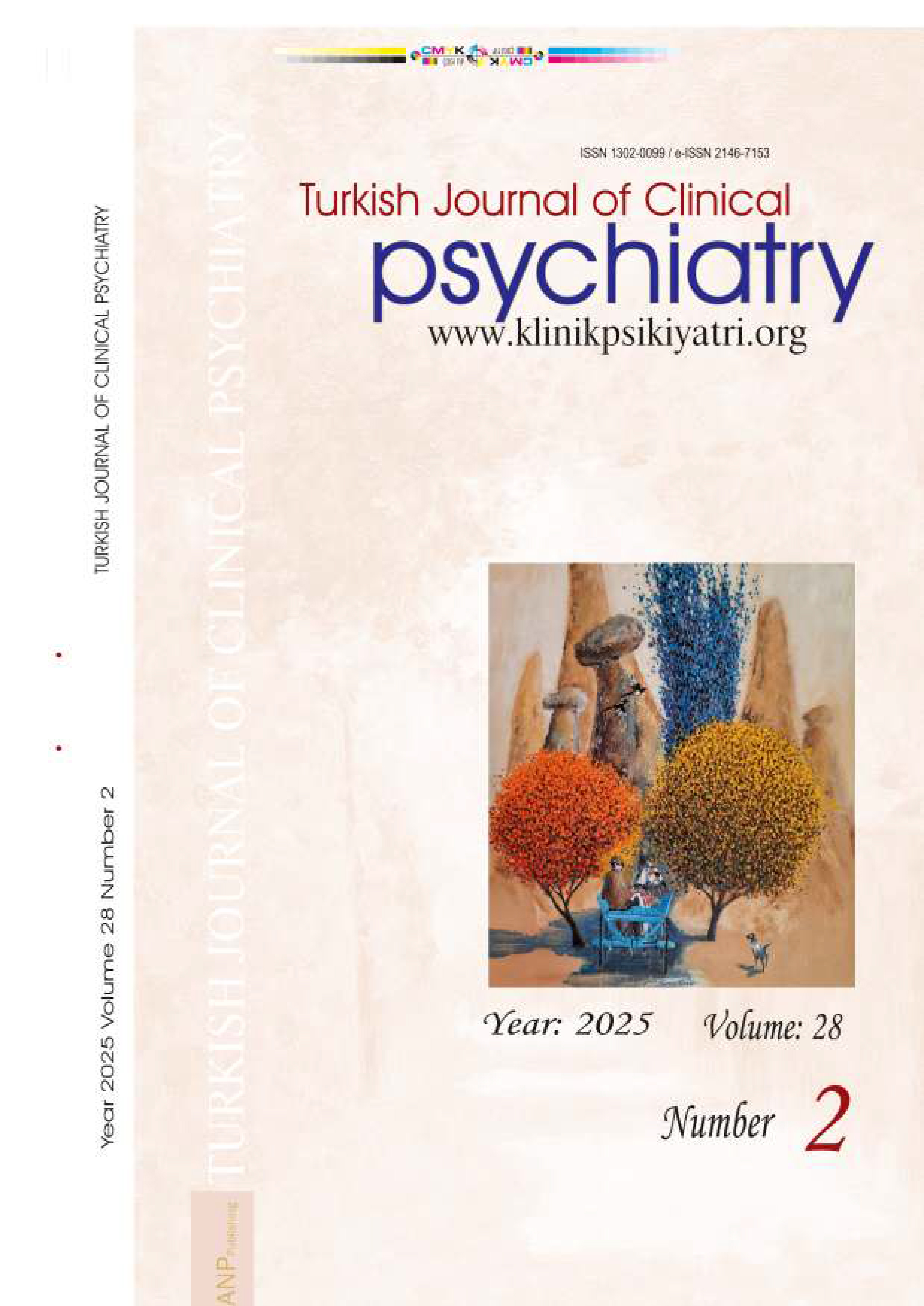





Volume: 13 Issue: 4 - 2010
| RESEARCH ARTICLE | |
| 1. | A Validity and Reliability Study of the Sexual Seif-Schema Scale Among Undergraduate Students Gözde Koçak, Hürol Fışıloğlu Pages 159 - 169 Objectives: The purpose of the present study was to translate the Sexual Self-Schema Scale into Turkish and to determine its basic psychometric properties. Method: In a sample of 306 undergraduate university students, the Sexual Self-Schema Scale, the Rosenberg Self-Esteem Scale and Extraversion subscale of the Eysenck Personality Questionnaire Revised-Abbreviated Form were applied. Results: Results indicated that the Turkish version of the Sexual Self-Schema Scale had an adequate level of reliability and validity. The factor structure of the Turkish version of the scale was found to be similar to the original version. Internal consistency coefficients of subscales, "Loving/Compassionate", "Sensual/Sti mu la- ting", and "Direct/Outspoken", and the total scale were shown to be.85,.82,.77, and.86, respectively. In addition to construct validity, observed significant increments in variance of sexual behaviors support the discriminant and incremental validity of the sexual selfschema measure for use in the prediction of sexual behaviors beyond the contribution of other constructs. Conclusion: The Sexual Self-Schema Scale is shown in the study to be an instrument aiming to measure sexual self-schemas of adult women and men. It was also demonstrated that the scale had reasonable internal consistency. Through the investigation of sexual selfschemas in an increased number of studies, it would be possible to better understand the concept of sexuality and the psychological consequences of holding different types of sexual self-schemas. |
| 2. | Sensation Seeking Behavior in Patients with Obsessive Compulsive Disorder Nergis Lapsekili, Özcan Uzun, Mehmet Ak Pages 170 - 176 Objectives: In this study, sensation seeking behavior was investigated in obsessive-compulsive disorder patients who did not use any treatment before. Method: 27 cases diagnosed according to DSM-IV and 27 healthy individuals were included in the study. Zuckermen Sensation Seeking Scale and Maudsley Obsessive Compulsive Questionnaire were administered. Results: Total and sub-scale sensation seeking scores of patients were lower than controls. In patient group, total scores of sensation seeking showed negative correlation with scores obtained from Maudsley Obsessive Compulsive Questionnaire. When relationship between sensation seeking total score and Maudsley Obsessive Compulsive Questionnaire sub-scale scores was assessed; most significant relationship was between sensation seeking total score and “suspicious" sub-scale. Conclusion: It was seen that sensation seeking of the cases was lower than the controls. This can be evaluated as the predicted degree of risk is higher in cases than the controls. It is thought that high harm avoidance behavior Cloninger had explained in the biosocial model of personality contribute to the formation and continuation of obsession and compulsion. High risk perception can explain high harm avoidance; and this-in accordance with the above study-will prepare ground for the formation of obsessions and compulsions. In Obsessive Compulsive Disorder, high risk perception is one of the patient's appraisals about the obsession thought to provide the continuation of the disease. In this sense, it can be thought that interventions on the thought about high risk perception of low sensation seekers can increase sensation seeking. |
| 3. | The Relationship Between PTSD Symptoms and W/SC-R Scores in a Group of Sexually Abused Children and Adolescents: A Preliminary Study Şahika Gülen Şişmanlar, Işık Karakaya, Sevda Özer, Belma Ağaoğlu Pages 177 - 184 Objectives: There are conflicting results about the relationship between Posttraumatic Stres Disorder (PTSD) and IQ (intelligence quotient). So, aim of this study is to get a better understanding about this relationship by evaluating the connection between PTSD symptoms and WISC-R (Wechsler Intelligence Scale for Children- Revised) scores. Method: Thirty five children aged between 7-13 years were recruited for the study. They had been sexually abused and were followed with the diagnosis of PTSD. Besides of DSM-IV-based (Diagnostic and Statistical Manual of Mental Disorders-Fourth Edition) clinical interviews, they were applied Children's PTSD-Reaction Index (CPTS-RI). Moreover, IQ level of the children were evaluated by WISC-R. Results: Verbal IQ score were found to be significantly lower than both performance and full scale IQ scores of WISC-R. When examining the correlation of PTSD symptom categories and WISC-R scores, a negative correlation between "re-expe- riencing" symptoms and verbal IQ score were observed. Additionally, the performance of children in "arithmetic and digit span" subtests were worse than that in the other subtests of WISC-R. Conclusion: Our study states a negative correlation between PTSD symptomatology and verbal IQ, more re-experiencing symptoms in children with lower verbal IQ level. The results of this study also give rise to thought that PTSD may negatively effect functions of attention and working memory. |
| 4. | Attitudes and Knowledge of Medical Students in Eskişehir About Schizophrenia Çınar Yenilmez, Gülcan Güleç, Damla Ernur, Anıl Aydın, Özge Yücel, Göksu Asil, Nuri Şengüleroğlu, Ömer Ayçan, Serenay Çetinoğlu, Zeynep Vatanseven, Derya Öktem, Meltem Genç Pages 185 - 195 Objectives: This study aimed to investigate the effects of psychiatric education on attitudes and knowledge of medical students in Eskişehir about schizophrenia. Method: 101 first-year and 101 fifth-year students at the University of Eskişehir Osmangazi Faculty of Medicine participated in the study. Students were given a form questioning gender, personal and family history of psychiatric disorder and were asked to answer some questions in an attitude questionnaire prepared for schizophrenia by "Association of Psychiatric Researches and Education Center" related to a case. The data were analyzed with the SPSS statistical package version 13.0 and Kolmogorov-Smirnov and Mann-Whitney-U tests were used. Results: There was no significant difference between the first and fifth year students in gender, personal or family history of psychiatric disorder ( P>0,05). Some statistical differences were found between the first and fifth year students in 5/8 questions of "overview and etiology" part, 5/8 questions of "public life" part, 5/8 questions of "treatment" part and 3/9 questions of "seeking behavior " part related to the schizophrenia case. Conclusion: It was found that the psychiatry internship provides students a positive attitude to understand schizophrenia and the significant proportion of questions about etiology, public life, treatment and seeking behavior. |
| REVIEW | |
| 5. | An Overview of the Proposed DSM-5 Diagnostic Criteria: is Vedat Şar Pages 196 - 208 American Psychiatric Association's Diagnostic and Statistical Manual of Mental Disorders - Fifth Edition (DSM-5) will be published in 2013. Proposals of revisions on diagnostic criteria of the existing DSM-IV categories and newly proposed disorders have been announced alongside recommendations about those to be eliminated or moved to other sections. This paper is concerned with overview and introduction of the current version of the proposed DSM-5 diagnostic criteria. DSM-IV was concerned with accurate representation of research findings, allowing a high number of concurrent diagnoses supported by a five axes evaluation system. Revisions proposed by DSM-5 project are aimed at achieving better clinical utility and prevention of excessive use of concurrent diagnoses supported by integration of the first three axes to a single one. On the other hand, a measure of severity is proposed for several diagnostic categories as a step toward dimensionality. In this paper, several sections of DSM-5 have been reviewed and rationals for proposed changes have been summarized. Among others, removal of traditional subtypes of schizophrenia, cancellation of the priority of Schneiderian symptoms as pathognomonic features of schizophrenia, and subsuming clinical consequences of environmental stress in a single section of trauma-, stres- or event-related disorders (including post-traumatic stress disorder) attract attention as revisions reflecting a progressive step in the history of psychiatry. |
| CASE REPORT | |
| 6. | Glioblastome Multiforme Case Starting with Global Amnesia and Dementia! Findings Ebru Timur Parlayan Pages 209 - 214 Dementia and depression are the most common neuropsychiatric syndromes seen in elder peoople. Transient global amnesia is most commonly seen in ages between 56 and 75. Depressions in older ages also show more cognitive deficiency. It is known that the depressif symptoms also accompany dementias which appear due to various resons in the old ages. The first sign of tumors located in some parts of the brain, especially in the corpus callosum, frontal- basal region and temporal lobe may be mental variations which may be mistakenly assessed as dementia or depression. Transient global amnesia may also be the first sign of brain tumors. 66 years old male patient demential findings were determined by neuropsychiatric tests on patient who lost his way due to transient loss of consciousness two weeks ago as he beat his head and who had forgetful I ness problems. The patient's story uncovered that he has been suffering from depression symptoms for the last two years. In his cranial MR, multifocal tumoral lesions were determined on patiens demonstrating atypical demential features following transient global amnesia. As a result of the operation after tumor resection, pathology was glioblastome multiforme. We wanted to show that clinical findings should be carefully evaluated on patients having mental changes with sudden onset and atypical demantial findings and wanted to emphasize the importance of neuroimaging. |










